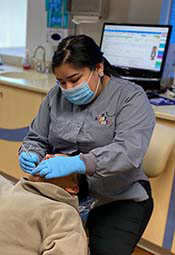“Braces behind teeth,” also known as lingual braces, are like standard braces except that they fit behind the teeth, rather than in front. The benefit of lingual braces is that they are practically unnoticeable. However, they are more expensive than other kinds of braces and may be uncomfortable for some. Just like Invisalign, they are a good option for braces for patients who are conscious about their smile.
Considering Braces Behind Teeth?
The word “braces” tends to conjure images of kids and teens revealing their metal with a smile. This is because orthodontists used to try and catch problems early when children’s mouths were easiest to change.
Nowadays, advances in orthodontic technology make it possible to correct crooked teeth at almost any age. But this brings a new set of concerns for adults. While young children might not be concerned about the look of their smile or speaking a little funny, adults certainly do worry about these things. Fortunately, there are options that make adult braces less obvious.
Types of Braces for Smile Conscious Adults
All braces are designed to straighten teeth, improving the look of your smile and making it easier to stick to an oral health routine. The most common options adults choose to hide their smile straightening are lingual braces, ceramic braces, and Invisalign.
- Lingual braces are the “braces behind teeth” that some people talk about – use the same metal brackets and wires used in traditional braces, but installed on the inside of your teeth to keep them hidden. You can feel lingual braces right up against your tongue when your mouth is closed.
- Ceramic braces are similar to metal braces in shape and size, but use tooth-colored or clear ceramic brackets that blend more naturally into your teeth. Some even use tooth-colored wires to keep your treatment even lower profile.
- Invisalign consists of a series of customized, clear BPA-free plastic tray aligners that fit around your teeth. Unlike other braces, they are removable. However, they need to be replaced every two weeks or so to keep your teeth moving in the right direction.
Explore this comparison of the different types of braces before you decide.
So Are Lingual Braces Right for You?
Lingual braces work just as well as traditional braces, helping to straighten your smile over time. There is little to no difference in the time they take to do their job, or in the steps, you take to clean them. So, most people can get braces behind their teeth if truly needed.
The main benefit of lingual braces is that, since they are tucked behind your teeth, they are virtually impossible to see when you smile or open your mouth. This makes many people less self-conscious about them. On the other hand, lingual braces can be uncomfortable for some people. The wires and brackets are up against the tongue, and some people have trouble getting used to this feeling.
For this reason, you should have a discussion with a qualified orthodontist to discuss your specific needs, issues, and budget. An orthodontist specializes in treatments like braces and Invisalign, having 2 or 3 more years of education and training than is required for a dentist. Together, you will have to weigh how the various options look, your timeframe, and your budget.
There may even be a chance that your orthodontist can start you on type of braces and switch to another if the discomfort is bad enough… Though keep in mind this is usually not recommended.
Your Certified, Professional Family Dentistry and Orthodontics
As a network of certified, professional dentists and orthodontists, MyOrthodontist can provide the evaluations and treatments you need, in an environment designed to put you at ease. Call us today to set up your visit, or read about your first orthodontic visit.


